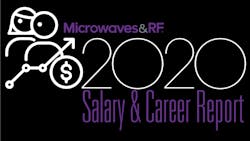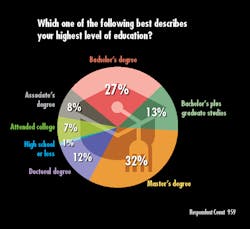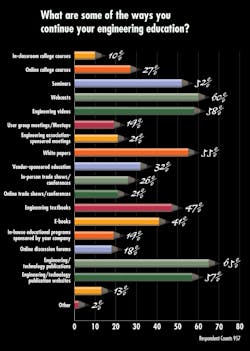Download this article in PDF format.
“Technologies are ever evolving, and competent engineers must keep up with the changes that come.” That statement from a respondent to our 2020 Salary & Career Report survey sums up the feeling engineers have about continuing their engineering educations. In our survey, we asked you to update us on your current level of education and how you prefer to learn about new technologies and skills. Does your employer encourage continuing education by footing the bill, and if so, in what modes? And how does the coronavirus pandemic figure into the picture? In this article, we’ll look at these topics with facts, figures, and anecdotal responses.
Education Levels Hold Steady Overall
First, let’s look at where you stand with your respective highest levels of education and see how that compares with the 2019 survey responses. The leading response was a master’s degree (32% vs. 33% in 2019), followed by a bachelor’s degree (27% vs. 30%). Last year, 9% of you reported holding a doctorate; this year, that number jumped up to 12%. Also, the number of respondents who have bachelor’s degrees and then followed that up with at least some graduate studies are holding firm at 13%. So, these survey results suggest that the levels of education among you are more or less on balance year on year compared to 2019.
So Many Ways to Learn
It’s good to see that the general level of education among engineers seems to be on the rise. But we also asked, “What are some of the ways in which you continue your engineering education?” The leading category this year: 65% report relying on engineering/technology publications for keeping up with trends. That’s followed by 60% who lean on webcasts and 58% who consume engineering videos.
Vendors to the OEM electronics industry have always done a great job at cranking out videos, white papers, and webcasts to educate engineers on their latest and greatest innovations. All of those mediums are free to consume, and webcasts can usually be viewed on demand if you’ve missed the live events.
Most in-person modes of continuing education—things like in-classroom college courses, seminars, user group meetings, and meetups—are down a few percentage points from last year’s results. Only 26% attended trade shows or conferences, and just 21% have been to engineering association-sponsored meetings.
Curiously, online learning is basically on par with last year and even down in some categories. You’ve been reading fewer e-books (41% vs. 44% in 2019), participating less in online college courses (27% vs 31%), and visiting online engineering discussion forums at a lower clip (18% vs 22%). Given the pandemic’s stifling of most away-from-home activities since earlier this year, this is a surprising result. It’s even more surprising given that a number of you called out COVID-19 as among the biggest challenges you face in staying current with relevant engineering information.
Impediments to Learning
Yet, the pandemic isn’t the most prevalent barrier to gaining knowledge. In their written responses to the question of challenges in maintaining their engineering educations, far more respondents cited lack of time in various guises: “Too much work, not enough time for self-training and hunting for resources,” goes a typical plaint.
This is, of course, not a new finding in the years of surveying our audience on career-oriented issues. Work-life balance is important to everyone, and not everyone wants to take training materials or extracurricular reading home. Lots of you would rather do it on company time, but it’s just not possible. “It’s hard to balance the intake of new information with working on active projects,” according to one respondent.
Another oft-cited issue is the sheer volume of material to be sifted through and prioritized. “The problem is focusing on the relevant issues. The available information is vast and overlapping,” said one respondent. Meanwhile, another laments that “sometimes the amount of information is too much, and sometimes too little.” Still others cite the combination of the pace of change in the industry and the number of topics to keep abreast of.
Continuing Education as a Benefit
Finally, we asked whether your employer invests in its engineering staff by reimbursing you for the cost of continuing education. On this front, the comparison to the 2019 survey results is a mixed bag. More of you report that your employers pick up the tab for things like trade show/conference fees (46% vs. 44% in 2019), professional certifications (26% vs. 25%), and, importantly, online training (31% vs. 26%).
But when it comes to some other avenues of continuing education, employers have become a bit stingier. They’re footing the bill less often for seminars (39% vs. 45% in 2019), engineering textbooks (25% vs. 27%), and college tuition costs (30% vs. 32%). More of you say your employers don’t cover continuing education costs at all (26% vs 23%). Clearly, in some instances, employers have reined in their investments in employees, perhaps ultimately to their own detriment.
As Henry Ford once said, “Anyone who stops learning is old, whether at twenty or eighty. Anyone who keeps learning stays young.” And to that, let’s heed the words of Bob Dylan: “May you stay forever young.”
About the Author
David Maliniak
Executive Editor, Microwaves & RF
I am Executive Editor of Microwaves & RF, an all-digital publication that broadly covers all aspects of wireless communications. More particularly, we're keeping a close eye on technologies in the consumer-oriented 5G, 6G, IoT, M2M, and V2X markets, in which much of the wireless market's growth will occur in this decade and beyond. I work with a great team of editors to provide engineers, developers, and technical managers with interesting and useful articles and videos on a regular basis. Check out our free newsletters to see the latest content.
You can send press releases for new products for possible coverage on the website. I am also interested in receiving contributed articles for publishing on our website. Use our contributor's packet, in which you'll find an article template and lots more useful information on how to properly prepare content for us, and send to me along with a signed release form.
About me:
In his long career in the B2B electronics-industry media, David Maliniak has held editorial roles as both generalist and specialist. As Components Editor and, later, as Editor in Chief of EE Product News, David gained breadth of experience in covering the industry at large. In serving as EDA/Test and Measurement Technology Editor at Electronic Design, he developed deep insight into those complex areas of technology. Most recently, David worked in technical marketing communications at Teledyne LeCroy, leaving to rejoin the EOEM B2B publishing world in January 2020. David earned a B.A. in journalism at New York University.




